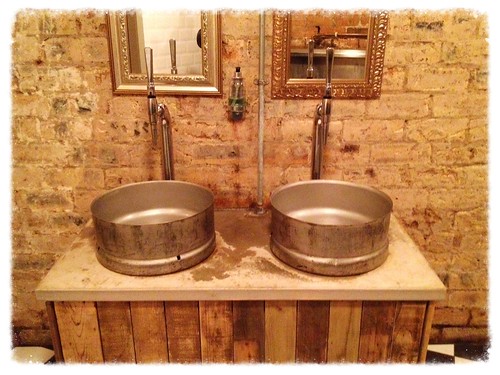Sinks at The Hanging Bat

(Photo from Rick Scully)
A bathroom faucet or tap might appear like a small element of a bathroom, but installing the right faucent can really make a difference in the overall look of your bathroom cabinets, counter or sink. If you've got a vintage single-handle tap, you could replace it with a brand new one developed especially for the do-it-yourself crowd. There's a good selection of finishes in single-handle taps and faucets, therefore you will end up in a position to find one which matches your bathroom decor.
Faucets developed for the Diy-er at heart are simple to install because you do the majority of the work above the counter. That means you don't have to lay on your backside with your face in a dark cabinet attempting to see what you're doing. Sink makers have discovered a method to pre-assemble the faucet system which removes the challenging task of fitting all the parts together. You have to do some spring cleaning and empty your bathroom cabinets to enable you or your partner to reach inside and hold tight the faucet while the other person tightens it. Only basic tools are required: an adjustable wrench (Plumber's wrench), a screwdriver and plumbing putty. Don't forget to turn off the water (under the sink) before you begin the faucet replacement.
A plumber will charge around $100 to remove an old single-control faucet to replace it with a new faucet. You can save yourself the $100 - purchase a new faucet for around $100 and install it yourself.Bathroom shower project - finished

(Photo from regan76)
When to Call the Plumber
It's not wise to go the DIY route if the existing faucet is old, the pipes are corroded or if the faucet is the two handle variety. Two handle faucets are a more complicated installation and this is a different type of faucet which you might be better off leaving to the pros to handle. Corrosion occurs because bathroom faucets deteriorate from calcium deposits left when water dries. This can cause leaks and interfere with water flow.- http://www.hometips.com/diy-how-to/bathroom-faucet-installation.html - Quickly install a bathroom faucet by following this expert do-it-yourself advice on how to install a bathroom faucet illustrated with step-by-step photos.
- http://www.diynetwork.com/how-to/how-to-replace-a-bathroom-faucet/index.html - Learn how to install a new faucet yourself and save money with this project from DIY Network.
- http://www.moen.com/consumer-support/installation-help - As the #1 faucet brand in North America, Moen offers a diverse selection of thoughtfully designed kitchen and bath faucets, showerheads, accessories, bath safety ...